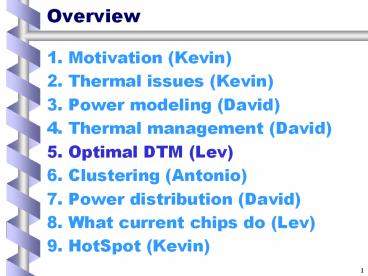Overview - PowerPoint PPT Presentation
Title:
Overview
Description:
Overview Motivation (Kevin) Thermal issues (Kevin) Power modeling (David) Thermal management (David) Optimal DTM (Lev) Clustering (Antonio) Power distribution (David) – PowerPoint PPT presentation
Number of Views:72
Avg rating:3.0/5.0
Title: Overview
1
Overview
- Motivation (Kevin)
- Thermal issues (Kevin)
- Power modeling (David)
- Thermal management (David)
- Optimal DTM (Lev)
- Clustering (Antonio)
- Power distribution (David)
- What current chips do (Lev)
- HotSpot (Kevin)
2
Optimal DTM strategies
3
Agenda
- Motivation
- DTM as an optimization problem
- Thermal models
- Theoretical analysis
- Numerical approach
- Example
- Possible applications
4
Optimal behavior
- There are various DTM techniques
- Can we say that a DTM method is good enough?
- Can we say that a DTM method may be tuned to
perform well? - Are there optimal strategies at all?
5
DVS scenario for 2 cores
Air
Heat Sink
Heat Pipe
Silicon
CPU1
CPU2
Unit
2D power Map
freq volt
freq volt
DVS1
DVS2
6
Optimal behavior (contd)
- We need a methodology for analysis of optimal
behavior - Offline analysis of existing strategies
- Guide for the design of new strategies
7
DTM as an optimization problem
- What is the optimization criterion?
- What is the set of possible strategies?
- What are the constraints?
8
DTM optimization criterion
- Goal maximize the performance
- To a first approximation, similar to frequency
maximization
9
DVS strategies
- A strategy f(t) dictates how to change frequency
and voltage - An optimal strategy extracts more clock cycles
than any other legal strategy
10
Constraints
- Thermal constraints do not exceed Tmax
- Frequency constraints do not exceed maximal
frequency - Additional constraints frequency should be
consistent with the voltage
11
RC networks
12
1D heat flow
13
3D heat flow
14
Theoretical analysis
- Build a mathematical formulation of the problem
- Solve the optimization problem by one of the
existing theoretical methods - Feasible only for simple thermal models
15
Theoretical analysis (contd)
- Optimal strategy for a single-RC model1
1From Cohen et. al, On Estimating Optimal
Performance of CPU Dynamic Thermal Management."
Computer Architecture Letters, Volume 2, Oct.
2003
16
Theoretical analysis (contd)
- Optimal strategy consists of three stages
- Start from the maximal frequency
- Decrease exponentially until the temperature
reaches Tmax - Run with the natural frequency that keeps the
temperature on Tmax
17
Numerical approach
- The mathematical problem is solved by numerical
methods - May handle rather complex thermal models
- Used as an offline procedure
18
Numerical approach (contd)
- Developed a methodology based on mathematical
programming - Handles large RC networks
- May handle time-dependent power profiles, leakage
power, etc.
19
Example
- A 3D thermal model
- Power is assumed to be proportional to the cube
of the frequency - A constant power profile
- A non-uniform power distribution
20
Optimal strategy behavior
- Power starts at a high value and decreases
exponentially until the maximal temperature is
reached - The maximal junction temperature is maintained,
while the power approaches the steady state
Area of potential performance gain
21
Optimal strategy behavior (contd)
- A non-typical thermal behavior (decreases while
power increases) - The reason a non-uniform power map
22
Possible applications
- Combining with power predictor
- Optimization of activity migration
- Just a nice fact for a single-RC thermal model
a PID controller (eg Skadron, HPCA 2002) that
is tuned for performance behaves similarly to the
optimal strategy































